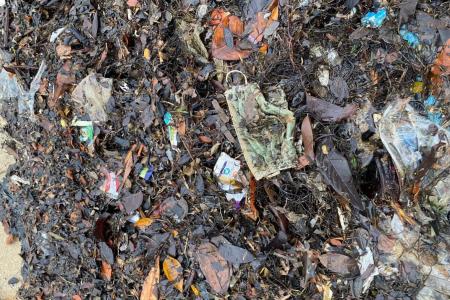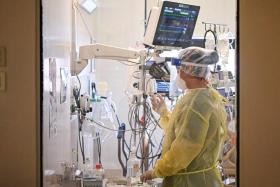Conservationists concerned by PPE showing up at beaches, nature trails
Environmental groups warn of long-term effect of pandemic on pollution
Conservationists are concerned by sightings of personal protective equipment (PPE) littered along beaches, nature trails and streets, with such items growing in ubiquity.
While quantities of such litter remain low, environmental groups here warn that this could just be the tip of the iceberg.
Ms Sam Thian, founder of Seastainable, said she has been involved in beach clean-ups for about 10 years, and it is the first time she is seeing masks, gloves and syringes on our shorelines.
Ms Thian, who has conducted 10 beach clean-ups in small groups at East Coast Park over the last two weeks, told The New Paper: "We pick up three or four masks per clean-up. The numbers aren't big, but all of a sudden we are seeing these medical items on the beach and if (the pandemic) goes on, we could be seeing more in time to come."
Globally, PPE waste has been showing up in water bodies and on beaches. Indonesian researchers found that medical waste amounted to 16 per cent of total garbage floating in Cilincing and Marunda river estuaries in March and April.
Last month, French non-profit Operation Mer Propre found dozens of gloves, masks and bottles of hand sanitiser in the Mediterranean and along the shoreline of the Cote d'Azur.
Mr Benjamin Moody, co-founder of Seven Clean Seas, said his group has seen PPE littered along the coastlines of Punggol and East Coast Park, as well as at nature trails such as Coney Island.
"While we cannot state that the net amount of waste has increased as of yet, I think for South-east Asia as a whole, the real effect of this pandemic on pollution will be seen in the not-so-far future," he said.
A spokesman for the Maritime and Port Authority of Singapore (MPA) told TNP that it has not observed any increase in marine litter due to the Covid-19 situation.
He said: "Marine litter is gathered along the shorelines when currents, tides or winds wash flotsam or debris towards the shorelines. Hence, the volume of marine litter along Singapore's shorelines fluctuates according to the monsoon seasons."
A contractor engaged by MPA removes flotsam from the sea on a daily basis, reducing the onshore accumulation of litter.
Mr N. Sivasothi, coordinator of the International Coastal Cleanup Singapore, said large pieces of plastic waste can smother marine habitats such as mangrove patches, while sea creatures may ingest or be entangled in smaller pieces with potentially fatal ramifications.
Ms Thian warned that high consumption of single-use products might inadvertently "become a habit that we carry with us even after the pandemic is over".
Mr Moody said there needs to be a shift in consumer habits to use reusable face masks instead.
Mr Sivasothi, who is also a senior lecturer at the National University of Singapore's department of biological sciences, said that the appearance of PPE along beaches and parks highlights the link between urban city centres and the sea.
He said: "When we don't dispose of our trash properly, it can get into our drains, our reservoirs, our rivers, and then into the sea. This is a clear indication that whatever we do in our urban living affects the sea."
Get The New Paper on your phone with the free TNP app. Download from the Apple App Store or Google Play Store now



